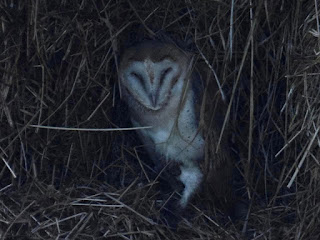I am currently walking down to an empty farmyard, whistling into the huge Fenland skies and returning without as much as a screech, a hiss or a curved winged fly past. My owls have gone. This is exactly as it should be but it takes a little getting used to when I have become familiar with seeing seven, eight or more owls flying in as I arrive after dark. It is actually a welcome occurrence as it means that the females are at their chosen nest sites and most likely already sitting on eggs. This is my twelfth spring of watching the owls and just as I listen to the Robin's duet as they call from tree to tree, or watch the Mallards exploring the ditches for the best nest site, so I have come to take comfort in this seasonal pattern too.
At the start of March the owls were still keen, indeed the females were exceptionally brave as they began to build up their breeding weight. Our eldest female would sit on the shed apex and peer down at me, or fly over for food so low and so slow that I could almost have reached out and touched her. She always took the food away from me and I knew this was a ruse. However familiar the owls may seem, they know to steer clear of the nest site until I have left. There were also two youngsters who always arrived together and flew in for food in a hasty and haphazard way. Twice I watched them gatecrash the party and saw one fly into the open sheds that border the farm driveway to eat its food. These youngsters had obviously been ousted from the farm but were opportunistically still flying in once the adults had taken their share. More than once I heard territorial screeching and there were feathers around the straw stack, a sure sign of a scuffle.
By the middle of the month all was quiet with the Barn Owls although the Kestrels still show well. One morning last week, Daddy Kestrel was waiting for me outside my house and flew alongside me for his breakfast. I watch out for his mate disappearing when I know, she too, will be nesting but she is still flying. Meanwhile, the Little Owls have become far more noticeable.I barely see them in the winter months but once spring arrives these dapper little birds make their presence felt. I hear them first, a range of vocalisations as they reestablish their territories and chide the Barn Owls when they come too close. As the evening become lighter I see them too. One evening, before dusk this week I saw them silhouetted in the bare branches, and one teatime a single bird sat motionless on the roof strut. I love their furious stares and their scolding voices, they are a welcome addition to my spring sightings.
I've walked down each evening under calm conditions, bright moonlight, raging wind and torrential rain recently and each time no one greets me, but tonight a single owl flew across the moonlight. I waited in the shadow of the barley store where I could see two of our four owl boxes.I had barely positioned myself when the owl reappeared and flew directly over me before it turned neatly and disappeared into the shed. I left immediately despite hoping to see more activity. I couldn't risk being seen and disturbing this pair. With my new found secret I hurried home smiling.







































